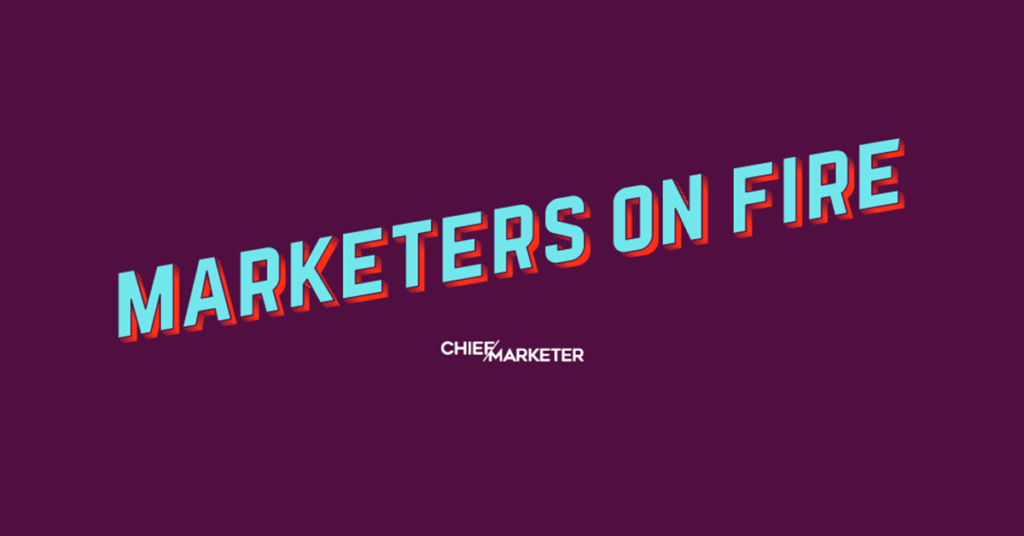Back in the ‘80s and ‘90s, Prudential Financial’s ad campaigns revolved around the symbol of a rock to convey a sense of financial strength, reliability and resiliency. This summer, it brought the iconic trademark back in a campaign that re-establishes “the rock” as a key part of its marketing message. And it’s a fitting time for it. According to brand research, more than two out of three Americans are concerned about their financial futures, and one in two say it’s more important to see strength and resilience in a financial service brand than it was a year ago.
Enter the brand’s “Who’s Your Rock?” ad campaign, premiered during the Opening Ceremony of the Tokyo Olympics in July, which revives the rock’s symbolism after more than a decade. We spoke with Prudential’s CMO, Susan Somersille Johnson, about the campaign’s strategic marketing goals; the influence her early career in engineering had on her marketing approach; how she champions inclusive teamwork; and the ways in which the pandemic has shifted Prudential’s marketing programs.

Chief Marketer: Being a year into your role as CMO, what are your goals at the company?
Susan Somersille Johnson: My goal at Prudential is to drive business growth. It’s pretty straight forward, and vital to the organization. We’re going to do that by connecting more closely with customers, creating distinction for the brand and energizing the brand around the world. In order to create distinction, we are going to amplify our purpose. We make lives better by solving the financial challenges of our changing world. That distinguishes us, and it drives everything we do.
CM: How have your previous positions in engineering influenced your marketing strategy?
SSJ: It was a non-traditional way into my current job. At the beginning of my career, I joined Apple as an engineer and I left as a marketer. And I learned a lot along the way. It is reflected in my current role in a number of ways. When I left engineering, I never thought I could use my technical skills, my analytical skills, as much as I am now in marketing. I didn’t think that you needed it. But since then, I had to develop more creativity, so I combine them both now. The beauty of it for me is that in marketing you don’t have to guess anymore. Using analytics, we can measure things. Now we can measure how our marketing channels are performing. And also we use it to predict consumer behavior.
CM: Can you talk about your specific approach to marketing throughout your career?
SSJ: For me, it’s all about growth. In a sense, I think of myself as the chief growth officer. But in order to do that, to grow, it’s about our relentless focus on customers and deeply understanding their unique needs, because they’re not a monolith. My approach is to keep flexibility with our campaigns so you can modulate as the circumstances change. We’ve learned to roll with the punches, which is so important now that it’s much more difficult to predict consumer behavior because it’s changing with the pandemic.
A good example of remaining flexible and rolling with the punches is our partnership with Playbill to sponsor Broadway. This month, Broadway officially is back, and that is a relevant cultural moment for people. And not just in this country, but around the world. When we realized how important it was during this time of stress, to bring back the art—and not just Broadway, but Off Broadway and Off Off Broadway—it’s something that we wanted to support. This is stunning to me: In the cultural sector of New York alone are 300,000 jobs and a hundred billion dollars in economic activity. This is something that’s really important to people right now. It’s a cultural touchpoint that we wanted to help bring back and help spark the economy.

CM: What’s your particular leadership style?
SJ: Inclusive teamwork. Teamwork is at the core of everything I do. An inclusive team is really important to me and I think that means different things to different people. To me, it means deeply understanding each other’s strengths and weaknesses and filling in for each other when you need to. When people talk about inclusion, you hear a lot about feeling welcome or feeling safe in an environment. Even a step further, for me an inclusive team [means] you’re actually celebrating each other and you cherish each other’s skills so that you become stronger.
CM: Speaking of inclusivity, how are you incorporating diversity, equity and inclusion initiatives at the company?
SSJ: As a Black woman, it’s one of the most important topics to me personally. For DE&I, Prudential is taking action. It’s very important to go beyond verbal commitment, so we are trying our best to hold ourselves accountable. A few things that we’re doing: We have made nine racial equity commitments, internally as well as externally, to improve racial equity. We have DE&I goals built into top executive compensation. A lot of companies started doing that last year; we did it in 2018. And then, we’re increasing transparency. We actually released data on our wage equity as well as diversity numbers. We take it really seriously and I’m very proud of this. We know we have a long way to go, but we are doing a lot here.
CM: What are the strategic marketing goals of your “Who’s Your Rock” ad campaign?
SSJ: “Who’s Your Rock” reaffirms the iconic Prudential rock symbol, which is one of the five oldest trademark symbols in the country. [The campaign] reaffirms what it stands for and helps connect with new generations and new audiences. It came out of our research around the pandemic and how consumers are feeling. People are anxious about the financials of the future, so it’s never been more important to remind them that we are this unwavering rock of support for them. The rock becomes synonymous with strength and resilience. [It’s known] for helping people reach new heights and giving people a platform to soar from. We premiered it in July at the Opening Ceremony of the Tokyo Olympics, which is also a symbol of reaching new heights.

CM: Let’s talk marketing trends. In your view, what are the top three that marketers should keep an eye on?
SSJ: The first is investing in more minority-owned and multicultural media. That’s important because audiences are turning to earned channels that reflect the community that they’re in. They are communities that they trust. So, we take a close look at how our target audiences use those venues. The second, I would say is not new: behavioral economics, which is improving day by day. The research continues to astound me. Behavioral economics helps us understand human behavior, which of course [is important] to marketing. The third is hybrid customer interactions that introduce IRL experiences. We need to go outside of traditional channels like email. We need to be where people are in real life. It’s clear that AI is going to play a real role here, because it will help tell us how to show up and in what [way].
CM: What are the top three qualities that aspiring CMOs should master?
SSJ: The first is easy: a relentless focus on the customer. Curiosity is so important, because you have to really want to know about the customer and understand them deeply. I learned this traveling and leading marketing around the world. As I would go to different countries, I had to develop a curiosity for the culture and how people think and what their behaviors are. The second one for me is technology, data and analytics, for reasons we talked about earlier. And then the third is creativity. It’s still key; creativity will always be important in marketing.
CM: We touched on this a bit already, but any other thoughts on how you incorporate data and analytics into your marketing?
SSJ: There are three ways that I incorporate data and analytics. One is more of a macro level and looking at the market. We use analytics to look at the target market and determine the opportunities. Where are the big gaps where their needs are not being met? And then the second is to predict behavior. That helps us determine the next best offer to meet their needs. And the third is measuring performance.
CM: Has the pandemic shifted budget allocations? If so, how?
SSJ: We looked to reach our target audiences where and how they spend their time with media. Digital channels (search, social, display, native, etc.) have seen a substantial increase in spend over pre-pandemic years. TV viewership habits are changing, and as people are moving to streaming subscriptions and Smart TV, we’ve upped the ante to reach our audience. Additionally, we’ve focused a healthy portion of our investment across live sports in 2021 to find an engaged audience watching live TV.
During the pandemic we held back investing in strategic partnerships and audio, but now we’re amping up both with an eye to use the data and learnings from these efforts to inform longer-term strategies and elevate brand platform storytelling. To best reflect our target audience’s diversity (beyond just targeted media) we are investing more in minority-owned media as well as multicultural media with a strong editorial voice.
CM: In terms of specific marketing programs, how has the pandemic has shifted your plans?
SSJ: In this pandemic, we’ve all been shaken. People are feeling unsteady, uncertain. They are looking for a stabilizing force, and we call them “the rocks” in their lives. We all have people we relied on who were there for us. That’s why we made the rock the centerpiece of our campaign. Our research shows that two out of three Americans are incredibly anxious about their financial future. One in two Americans say that it’s more important, compared to a year ago, to see strength and resilience in a financial service brand. A lot of information pointed us in this direction.
One of the things it led us to is our sponsorship with USA climbing. It’s the first year that rock climbing was in the Olympics. Our goal there was to help build the talent of the team, to help with travel and training, and to elevate the team’s presence and their success globally—to be that rock of support.
Another example would be Broadway. We’re so proud of our partnership with Playbill to reignite this cultural and economic engine. Last weekend there was a three-day festival that we partnered with Playbill on to celebrate the comeback. It was very emotional for everybody, because when Broadway closed on March 10th last year, all 41 Broadway theaters closed down, as well as Off Broadway and Off Off Broadway. Those people have been out of work for 18 months. And it’s not just actors. It’s makeup art and ushers and bartenders. We launched a free financial wellness digital site for the theater community, at prudential.com/yourrock, to help people get back on their feet because we want those people of Broadway to keep doing what they do best, which is making the magic for all of us. We’re really proud to be a part of that.





